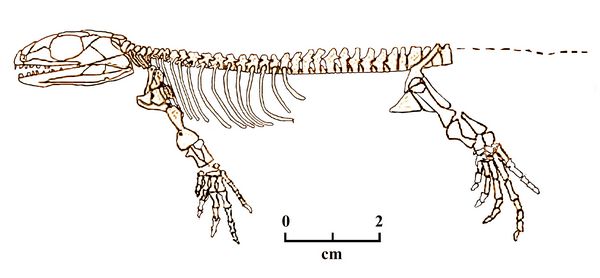Athena Review Image Archive ™
Casineria kiddi skeleton

Skeleton of Casineria kiddi (after Paton et al.)
Casineria kiddi is the earliest known fossil taxa classified as an amniote or early reptile. Dating from the Mississippian period at about 335 mya, it was discovered in 1992 by an amateur paleontologist on the shore of Cheese Bay, Scotland, in Visean (Late Mississippian) formations. It is classed as a transitional form between amphibians and reptiles, in the clade Archaosauromorpha, and the order Eureptilia.
Casineria was a small insectivore with a body length of 12-16 cm and a skull length of 2.5 cm. It had five fingers with claws, the earliest evidence of claws. Traits linking Casineria with early reptiles include lighter leg bones, unfused ankles, and toes terminating in claws.
Casineria had a mixture of anatomical features, some from the amphibian reptiliomorph groups such as Seymouriamorpha and Diadectomorpha. The
skull of Casineria had no otic notch and probably no tympanic membrane
or eardrum, reducing its ability to hear high frequency sounds.
Development of the middle ear region to enhance hearing of airborne
sound vibrations is one of the diagnostic traits of early
reptiles.
Reference:
Paton, R. L., T. R. Smithson, and J. A. Clack. An amniote-like skeleton from the Early Carboniferous of Scotland, Nature 398, pp. 508-513
.Copyright © 1996-2020 Rust Family Foundation (All Rights Reserved).